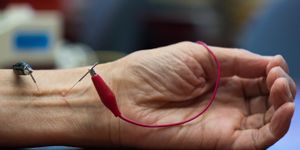Scientists have described a new kind of probe that improves investigators’ abilities to monitor the interactions of the intricate neural networks of the brain.
Published in Nature Communications and developed by a team at Vanderbilt University, the probe uses an enzyme called luciferase, which naturally produces light in organisms like fireflies and has been adapted for use in biomedical research. The new tool is a genetically altered form of the luciferase enzyme.
"For a long time neuroscientists relied on electrical techniques for recording the activity of neurons. These are very good at monitoring individual neurons but are limited to small numbers of neurons. The new wave is to use optical techniques to record the activity of hundreds of neurons at the same time," explained the leader of the work, Carl Johnson, the Stevenson Professor of Biological Sciences at Vanderbilt.
"Most of the efforts in optical recording use fluorescence, but this requires a strong external light source which can cause the tissue to heat up and can interfere with some biological processes, particularly those that are light sensitive," he continued.
After working with bioluminescence in "a scummy little organism, the green alga Chlamydomonas, that nobody cares much about,” the researchers aimed to fuse luminescence with optogenetics – a technique that utilizes light to manipulate cells of live tissue, especially neurons. They knew that such a method would be a great tool for studying the brain.
"There is an inherent conflict between fluorescent techniques and optogenetics. The light required to produce the fluorescence interferes with the light required to control the cells," Johnson explained. "Luminescence, on the other hand, works in the dark!"
Johnson worked with his team to genetically modify a luciferase from a luminescent type of shrimp such that when exposed to calcium ions, it emits light. His collaborators in Biological Sciences, Associate Professor Donna Webb, Research Assistant Professor Shuqun Shi, post-doctoral student Jie Yang and doctoral student Derrick Cumberbatch, along with Professor Danny Winder and postdoctoral student Samuel Centanni in Molecular Physiology and Biophysics worked to exploit a virus that infects neurons, attaching it to a sensor molecule so the sensor ends up in the interior of the cell.
The calcium ions were selected since they play a role in the activation of neurons. While calium levels are often high in the area around neurons, inside the nerve cells the calcium level is typically much lower. That internal calcium level shoots up when a signal from another neuron is received.
The new calcium sensor was tested with an optogenetic probe called channelrhodopsin, which causes calcium channels on the outer membrane of neurons to open up and allow calcium to rush inside the cell. By growing neurons in culture, the researchers saw that stimulating the probe with flashes of light caused the luminescent enzyme to visibly react to the calcium influx.
The investigators also tested the probe with sections of mouse hippocampus, an area of the brain with thousands of neurons. When a high concentration of potassium ions was dispensed onto the slices, another way to open the calcium channels, the sensor brightened and dimmed in response to the changes in calcium levels.
"We've shown that the approach works. Now we have to determine how sensitive it is. We have some indications that it is sensitive enough to detect the firing of individual neurons, but we have to run more tests to determine if it actually has this capability," Johnson concluded.
If you’d like to know more about luciferase, check out the video above.
Sources:
AAAS/Eurekalert! via
Vanderbilt University,
Nature Communications








